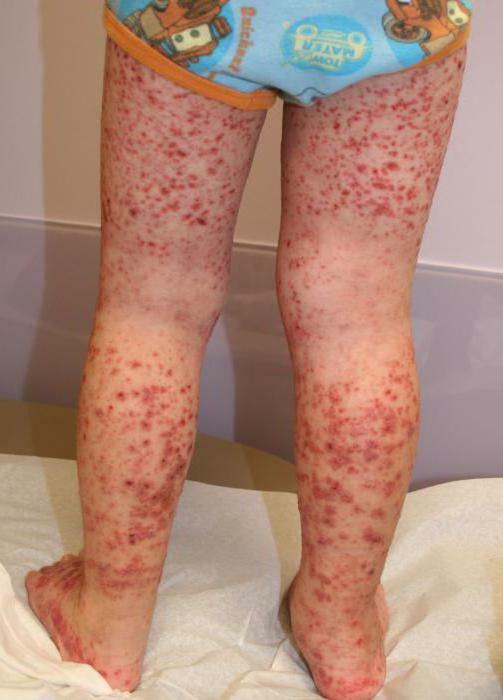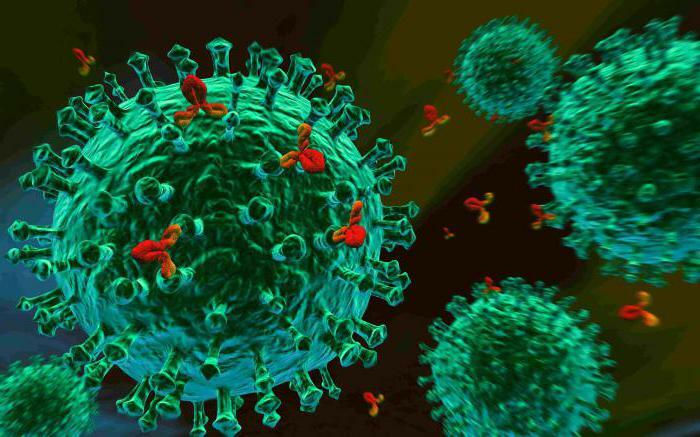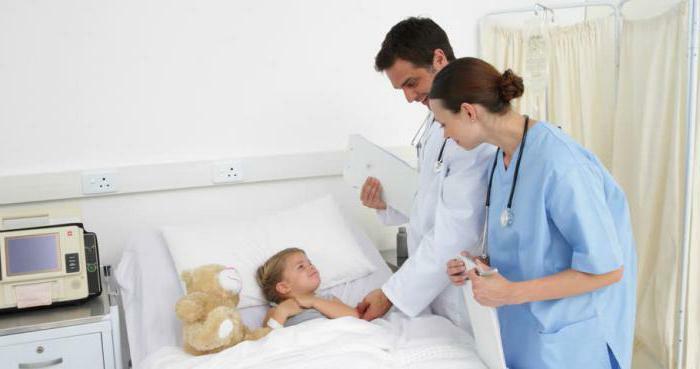Vasculitis in a child: hemorrhagic, allergic. Causes, symptoms, photos, treatment, predictions
Vasculitis is a whole group of pathological conditions. They are united by one common characteristic - an inflammatory process in the walls of blood vessels, leading to their damage and gradual destruction. Under the threat can be both large veins and arteries, and small capillaries. Progressing, the disease affects adjacent tissues and internal organs, which disrupts their normal functioning and frustrates the work of the whole organism.
Pathologies are susceptible to both men and women of all ages. Especially dangerous are those cases when vasculitis occurs in a child. A young unformed organism can not cope with the disease on its own. Timely appeal for medical help will help avoid complications. 
Varieties of vasculitis
Vasculitis is divided into a number of features: the type and degree of vascular lesions( arteries, veins, capillaries), the localization of the focus, its size, etc. This makes their classification quite complex, in addition, it is often revised. However, two large groups of vasculitides should be distinguished:
- systemic - lead to tissue and organ damage due to impairment of their blood supply;
- cutaneous - are manifested in the form of specific rashes on the skin, rarely leading to complications.
Also for the main reason of its occurrence, vasculitis is divided into the following groups:
- primary - emerged as an independent disease due to the failure of immune mechanisms;
- secondary - appeared against the background of other diseases( infectious, viral, parasitic, etc.).
Vasculitis in a child and adult is subjected to a single classification.
What is the risk of vasculitis in children?
If vasculitis develops in a child, then the risk of its generalized course increases, ie, spreads throughout the body. Unformed children's body can not cope with the pathological process, and the disease is rapidly progressing. Therefore, the onset of the disease can occur in an acute form. And after recovery, the probability of relapse increases.
Fever, worsening general condition, decreased appetite, a characteristic rash that causes discomfort and itching - signs that can recognize vasculitis in children( photo below). The situation is complicated by the fact that the child starts to comb the problem areas, than traumatizes the skin, provokes the formation of scar tissue. Acute infection penetrates into the blood, this further worsens the condition and slows the healing process.
The situation is complicated by the fact that the child starts to comb the problem areas, than traumatizes the skin, provokes the formation of scar tissue. Acute infection penetrates into the blood, this further worsens the condition and slows the healing process.
In the presence of complications, any vasculitis can flow into other heavier forms. Then the affected are not only the vessels of the skin, but also large and small arteries, and veins of other areas of the body and internal organs. Muscles and joints that do not receive adequate nutrition and blood supply, gradually atrophy and lose mobility. Such dangers entail vasculitis in the child. Treatment and qualified care should be timely.
Hemorrhagic vasculitis in children
Hemorrhagic vasculitis is also known as Shenlen-Henoch disease. A fairly common disease in children from 4 to 7 years, but can occur in infants. The causes of the appearance - the transfer of infectious diseases( viral, bacterial), parasitic infestations, various vaccinations, food allergies.
The first evidence of the manifestation of the disease is a hemorrhagic skin rash of varying intensity. Most often it is located on the lower limbs, near the joints, folds. Very rarely, rashes appear on other parts of the body - palms, feet, neck, face. At this stage, the lesion spreads to the small vessels of the skin. This is the main symptom by which hemorrhagic vasculitis in children is determined. 
Symptoms characteristic of the disease may appear in parallel with skin rash or later. This defeat of the joints, manifested in the form of pain, inflammation, edema. It is possible to involve the digestive organs in the pathological process, which is accompanied by heaviness in the abdomen, colic, nausea, vomiting.
In the 1st or 2nd year of life, the development of a lightning-fast form is possible, which greatly complicates hemorrhagic vasculitis in children. The causes of this are the transfer of so-called childhood infections - scarlet fever, chickenpox, rubella, etc. The course of such a disease is always acute, characterized by excessive manifestation of all symptoms and can be dangerous for the child's unformed body.
Clinical forms of
For convenience in clinical practice, hemorrhagic vasculitis can be divided into the following forms:
- Simple form. Known as dermal purpura. It appears in the form of a reddish rash - this is the most basic diagnostic symptom and symptom. Most often affects the lower limbs, rarely rises higher.
- Skin and articular purpura. More severe form of manifestation of the disease. In addition to skin rashes, joint damage occurs. This is accompanied by pain and swelling. The knee joints suffer especially badly, at least - ulnar and radiocarpal.
- Abdominal purpura( syndrome).It is accompanied by pains and cuts in the abdomen, vomiting, nausea. With only this symptom, it is extremely difficult to diagnose hemorrhagic vasculitis in children. The causes of the disease - the defeat of the abdominal cavity, namely the gastrointestinal tract.
- Kidney syndrome. It often develops against the background of other signs of the disease.
- Mixed form. Can combine at the same time 3 signs or all.
- Rare shapes. Expressed in the defeat of the lungs, the nervous system, genitals. Occur in single cases.
Causes of
Hemorrhagic vasculitis is referred to as immunocomplex disease. In its appearance and course involved immune complexes - circulating antigen-antibody( AG-AT) compounds in the blood.  Their appearance is considered a response to the penetration into the body of foreign or pathogenic agents - fragments of cells, toxins, bacteria, microscopic fungi, viruses, protozoa( parasites).That is why hemorrhagic vasculitis usually develops a few weeks after the transfer of infectious diseases or vaccination.
Their appearance is considered a response to the penetration into the body of foreign or pathogenic agents - fragments of cells, toxins, bacteria, microscopic fungi, viruses, protozoa( parasites).That is why hemorrhagic vasculitis usually develops a few weeks after the transfer of infectious diseases or vaccination.
Typically, complexes of AT - AG are destroyed by special blood cells - phagocytes. But sometimes they can accumulate in the bloodstream, "settle" in the adjacent tissues and organs, cause inflammation. In addition to the appearance of AG - AT complexes, the permeability of the vessel walls increases, the complement system, proteins participating in the immune reaction, is activated. These parameters are used for laboratory diagnostics.
Diagnosis of the disease
Vasculitis in a child is diagnosed on the following grounds:
- The presence of skin rashes of purple and red hues. Spots of small diameter, convex shape. May occur on any part of the body, but more often on the lower limbs.
- Abdominal( from Latin abdomen - stomach) pain. They can have a non-permanent character, amplify each time after eating.
- A biopsy( examination of a tissue fragment) of venule or arteriolar walls demonstrates an increase in the number of granulocytes.
The laboratory data are not diagnostic in this case. However, attention is drawn to increasing the number of immunoglobulins of type A in the blood serum. Also important indicators can be a high titer of Anti StreptoLysin-O( ASL-O) and sedimentation rate of erythrocytes( ESR), which diagnose vasculitis in children.
Forecasts can be favorable. In some cases, all symptoms disappear about 30 days after the acute manifestation of the disease. However, there is a risk of developing kidney failure, complications from the gastrointestinal tract or damage to the central nervous system. 
Hemorrhagic vasculitis in children: treatment of
Treatment of hemorrhagic vasculitis begins only after the specialist has finally established the diagnosis and causes of the disease. Therapy will depend on the phase of the disease and the degree of its development.
In any case, limit the motor activity. This is especially important during the acute course of the disease. Bed rest is prescribed up to a stable disappearance of skin rashes. Its average duration is approximately 3-4 weeks. Violation of this condition can provoke repeated hemorrhagic eruptions. When complications arise and the acute course of the disease, bed rest is prolonged.
Be sure to prescribe a diet with a strict exception from the diet of allergenic and potentially allergenic foods. If the disease occurs in the form of an abdominal syndrome, then diet No. 1 is prescribed. When complicating the situation with severe nephritis - diet number 7( exclude salt, meat, cottage cheese).This diet will reduce the unpleasant manifestations, which leads to hemorrhagic vasculitis in children.
Treatment, regardless of the form of the disease, includes the use of antiaggregants - drugs that reduce thrombosis, as well as activators of fibrinolysis - substances involved in the "dissolution" of blood clots. The composition and quantity of medicines, their dose and duration of administration are approved by the attending physician.
Since the onset of the disease is associated with the launch of immune mechanisms, the treatment consists in removing the AG-AT complexes from the body. In severe disease and the absence of contraindications, a mechanical purge of blood - plasmapheresis - is performed. This procedure will remove from the blood not only immune complexes, but also pathogenic bacteria, microscopic fungi, toxins. 
Allergic vasculitis in children
The cause of this disease is an allergic reaction. Typically, this is an immune response to medical products, food or infection in the body. As a result, there is inflammation and damage to blood vessels, mainly in the skin. Most often it develops in children under 15 years after the transfer of infectious diseases or the course of drug treatment. Sometimes the reason why allergic vasculitis occurs in children may not be clear. Then a thorough study of the medical history is necessary.
The main symptom is an extensive rash that causes itching. It has the appearance of spots and / or protuberant tubercles of violet or red-lilac in large areas of the skin. Basically, they appear on the legs, hips, buttocks. Possible the formation of blisters and ulcers, scarring of damaged vessels. Usually, allergic vasculitis passes independently for several weeks. However, complications in the form of damage to internal organs due to a violation of their blood supply.
Varieties and forms of
Depending on the diameter of the affected vessels, the following are distinguished:
- superficial( dermal) allergic vasculitis - affects the capillaries, arterioles and venules that lie in the skin;
- deep or dermo-hypodermal - occurs when arteries and veins of medium size are involved in the pathological process.
Depending on the stage of development of skin rash, several forms of the disease are distinguished:
- papular - rashes bulging, palpable, pigmented;
- vesicles - vesicles( vesicles) with liquid contents are formed;
- pustular - cavities filled with pus appear;
- ulcerative - necrotic ulcers appear on the place of the pustules;
- scarring - accompanied by scarring of damaged skin.
Treatment of allergic vasculitis
It is aimed at reducing inflammation by taking medications. The complex therapy also includes the use of drugs that reduce the formation of thrombi( antiaggregants), increasing vascular tone, and antihistamines to reduce allergic manifestations. If the disease is recurrent, you can not take medication used earlier, it is possible that the body has developed resistance to them.
To exclude the influence of food allergic agents, the administration of enterosorbents is prescribed. These drugs bind and remove toxins from the intestine, preventing them from entering the bloodstream. In addition, a strict diet with the exception of foods that can cause an immune response is needed. These are mandatory measures when the diagnosis of vasculitis in children.
Causes of the disease can be varied. Sometimes, if necessary, exclude drugs and medications that can lead to an allergic reaction. The duration of therapy depends on the nature of the course of the disease( wavy or recurrent).
What is important for parents to know?
Parents need to be very careful about any rashes on the baby's skin. Even to those that seem insignificant, at first glance. It is important for parents to understand that vasculitis in a child can appear undulating: the periods of remission are replaced by relapses. And the symptoms of a newly emerging disease may differ from those that were earlier. Timely appeal for medical help will help to avoid unpleasant consequences. 
It is not necessary to independently prescribe the child treatment if the vasculitis was suspected. In children, the symptoms of the disease can be ambiguous. Diagnosis and treatment should be handled by a qualified specialist. Especially, one should not show independence when choosing immunostimulating and immunomodulating drugs. After all, the main reason for the emergence of any form of vasculitis - a violation of the mechanisms of protective functions of the body.
To prevent the recurrence of a child's ailment, simple measures can help:
- limiting the amount of stress factors;
- providing a healthy diet, an active lifestyle;
- presence of light physical exertion;
- strengthening of immunity.
It is important to understand that the illnesses borne by a child at an early age can adversely affect his physical and mental development.
